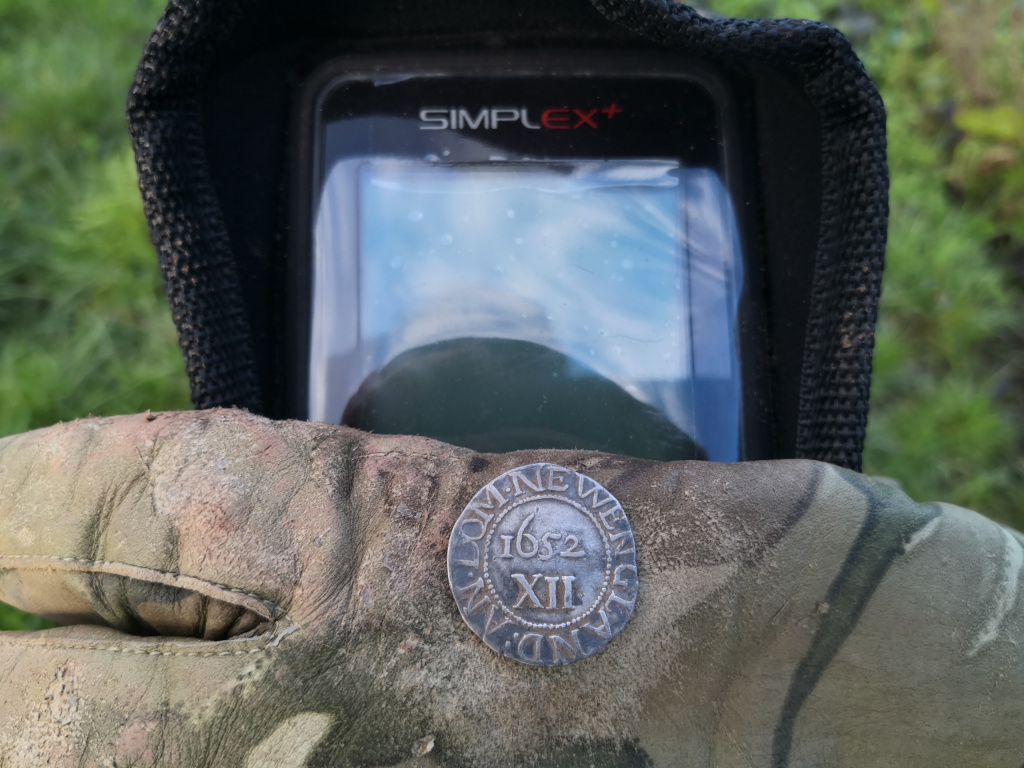Massachusetts Oak Tree Shilling
The person who sent in this coin asked to remain anonymous. I’m uncertain about whether or not it is a detecting find.

UPDATE: As you will see in the comments below, the finder has confirmed “This was indeed a detector find 1 foot down found with a simplex plus” and kindly provided a picture.
Within the inner circle on the obverse is an oak tree and the surrounding legend reads IN MASATHVSETS. Within the inner circle on the reverse is 1652 XII in two lines and the legend on this side reads NEW ENGLAND: AN: DOM: Therefore, this is an example of one of the earliest forms of silver currency used by settlers in North America.
Mayflower sails to North America
In 1620 the Mayflower transported a group of English religious dissenters to Massachusetts in North America. This group arrived little more than a dozen years after the first English settlers had based themselves in Virginia. For a number of years sea shells, furs, skins, corn, musket balls and tobacco were used as a kind of currency when trade was done between the settlers and the native Indian population.
Need for coins
However, traders who brought goods in ships sometimes demanded that payment was made in coins. No doubt this caused problems at times, as gold and silver currency was in short supply. In order to alleviate this situation the leaders of the Massachusetts Bay Colony eventually authorised the manufacture of the first-ever Massachusetts silver coins to be struck in North America.
Boston mint set up
A mint was set up at Boston and the first coins issued were silver discs stamped on the edge with NE for New England. A coin as simple as this proved to be easy to forge, so a more complicated design was speedily introduced. After the execution of Charles I early in 1649 England had declared itself to be a Commonwealth and Republic, so the new North American coins did not bear the portrait of a king.
They had a willow tree with IN MASATHVSETS around it on one side and NEW ENGLAND AN DO (or DOM) around 1652 and XII (or VI or III) on the other side. Later on the willow tree was replaced by an oak (1660-67) and later still it became a pine (1667-82). All were struck to the sterling standard (925 parts fine silver out of each 1000) and weighed 72 grains but the flan size varied, the later shillings (post 1675) being noticeably smaller than the earlier ones.
Boston shillings in England
As this and similar coins were struck to circulate and be used in North America it might be assumed that few if any people in England would know anything about them. In actual fact they must have been widely recognised in commercial circles, for in this country they were known as ‘Boston shillings’ and are said to have circulated at a face value of nine or ten pence. The different in face value between the North American shillings and their English counterparts is because the former weighed about 20% less than the latter.
Finds in England
Quite a number of Massachusetts coins have been found in England, which will have arrived here through trade or travel. They are rare but not very rare but being amongst the earliest coins used in North America they usually sell for high prices. However, prices can be somewhat up and down. Copies of the whole series are known, so this coin would need to be thoroughly checked out to ensure it is genuine.
Valuation
The coin pictured here is a little weak on part of the obverse legend but it is otherwise in VF condition. If offered for sale in an auction in England I’d expect the pre-sale estimate to be in the region of £3,000 to £4,000. The eventual hammer price would depend of the amount of competition between prospective buyers in the saleroom.
Valuation Service
If you would like your coin identified or valued, please read about my valuation service and contact me


I have weighed this now it is 4.5grams
Fresh out the ground
Many thanks for the picture – I’ve updated the article
This was indeed a detector find 1 foot down found with a simplex plus